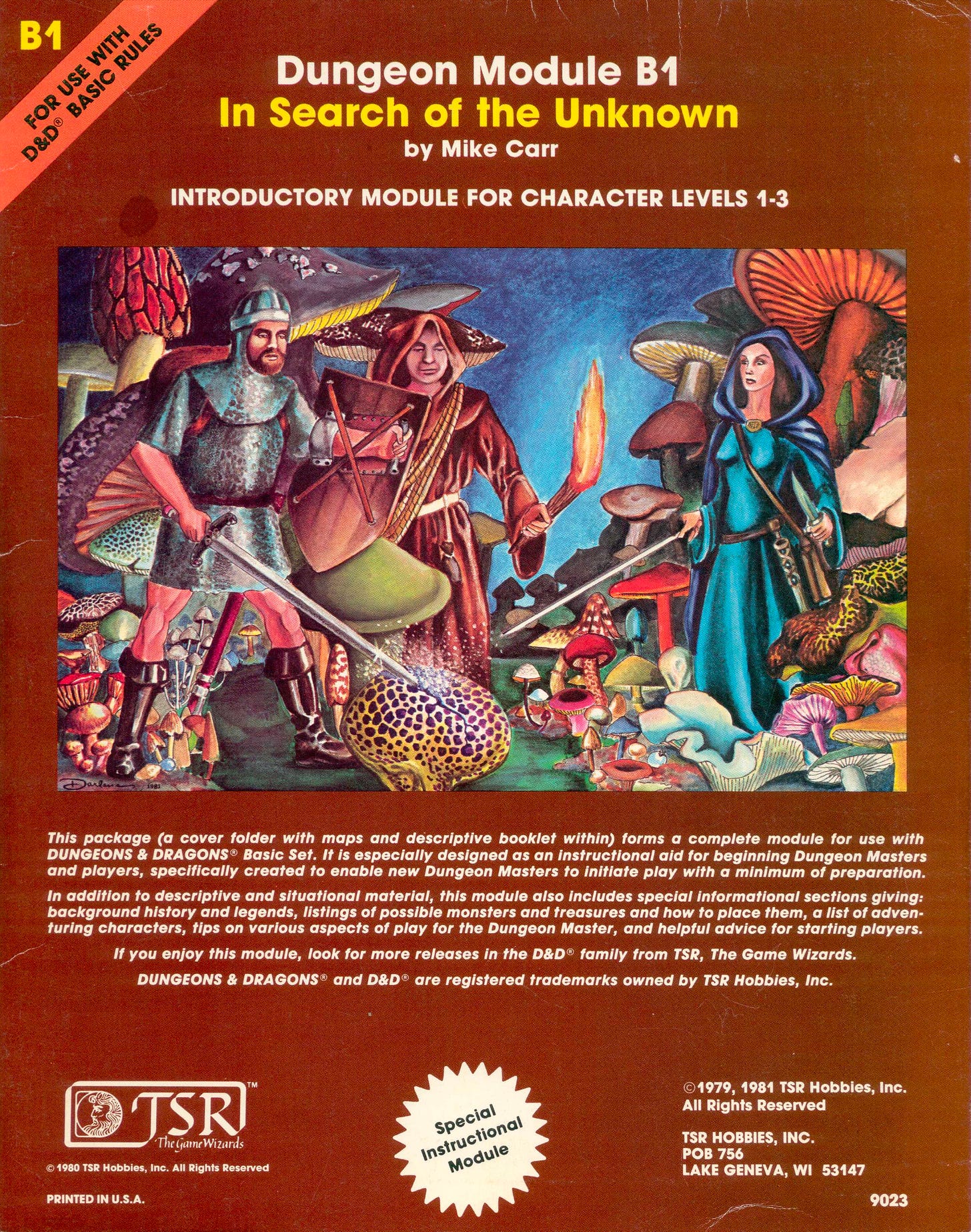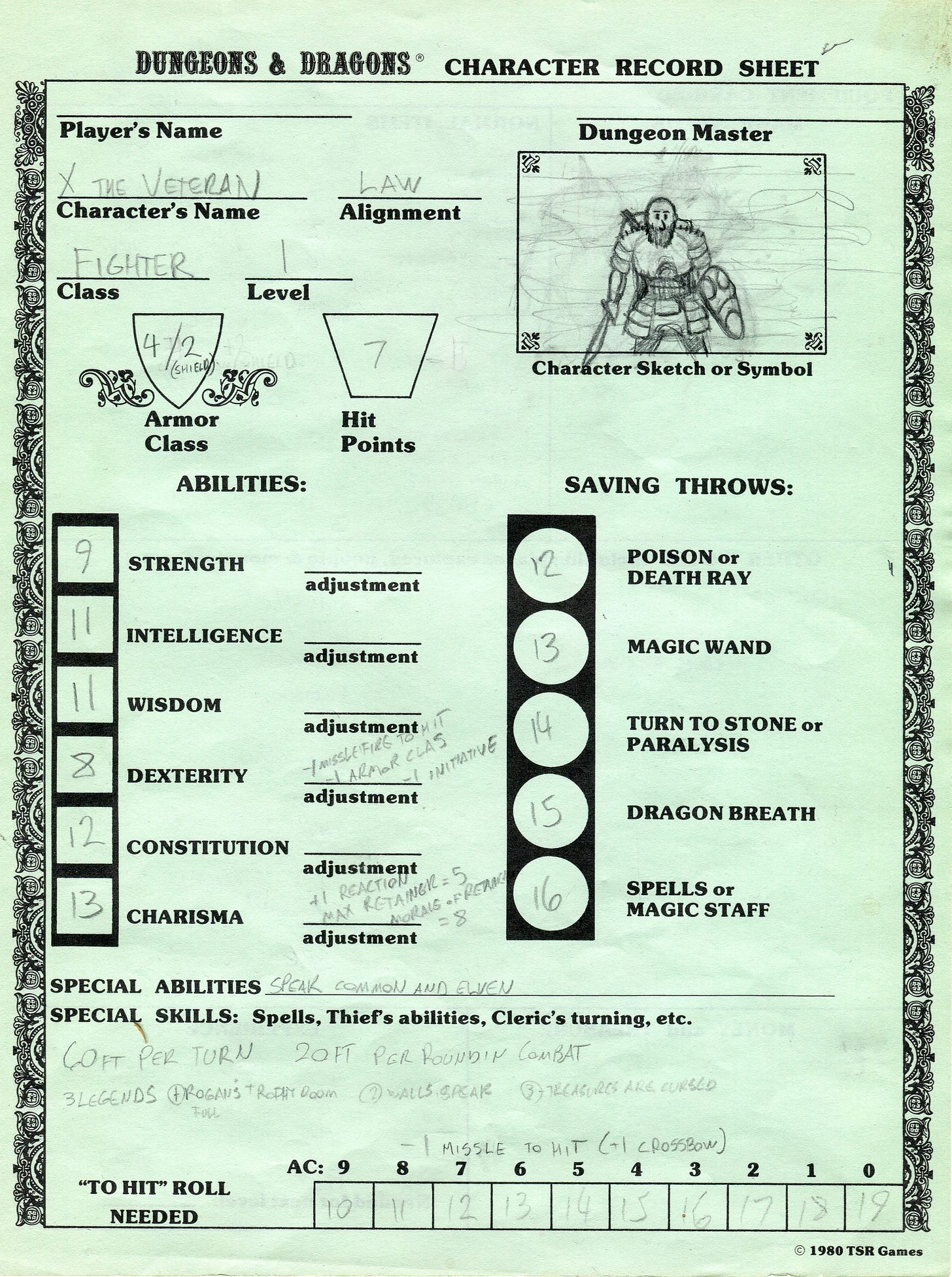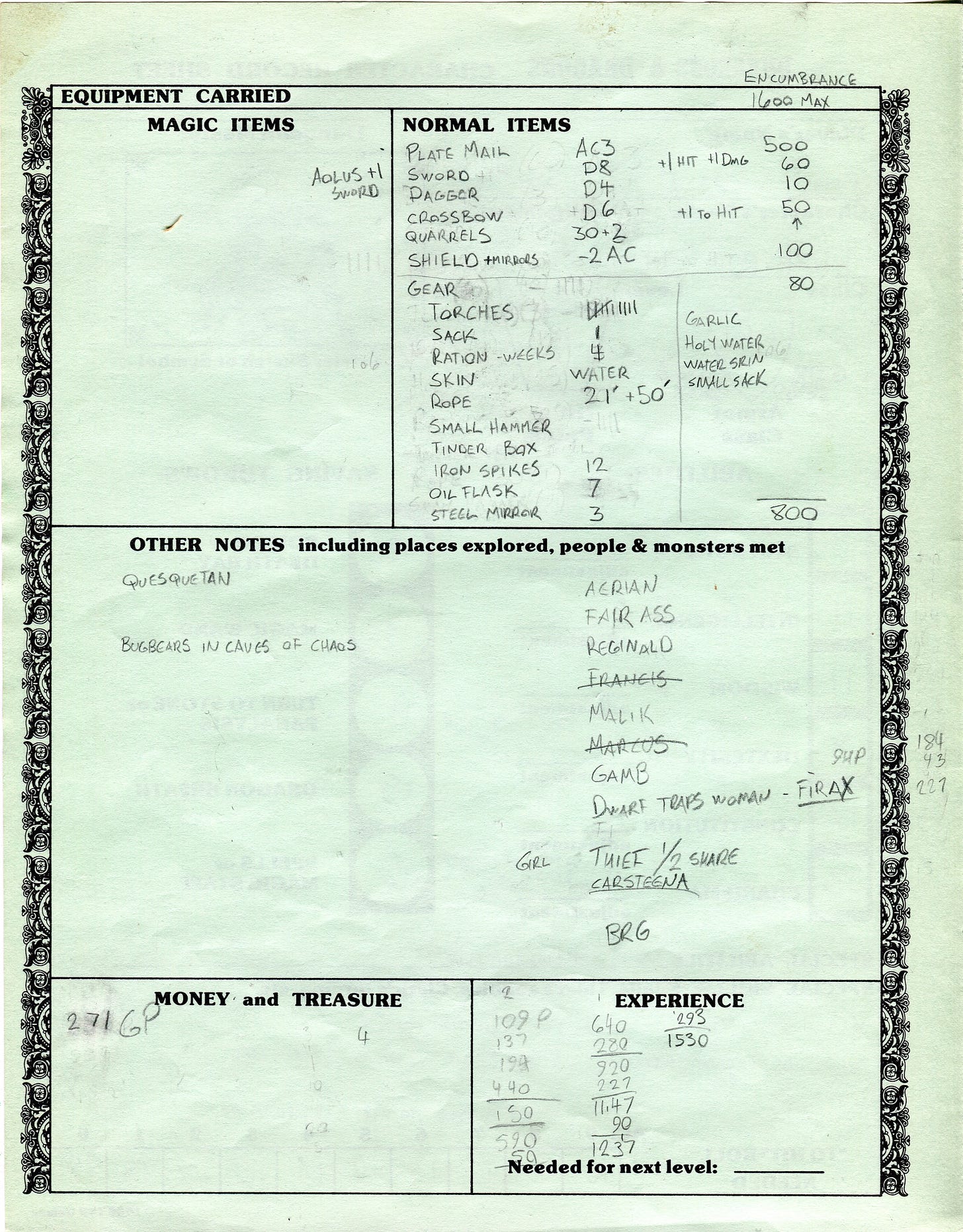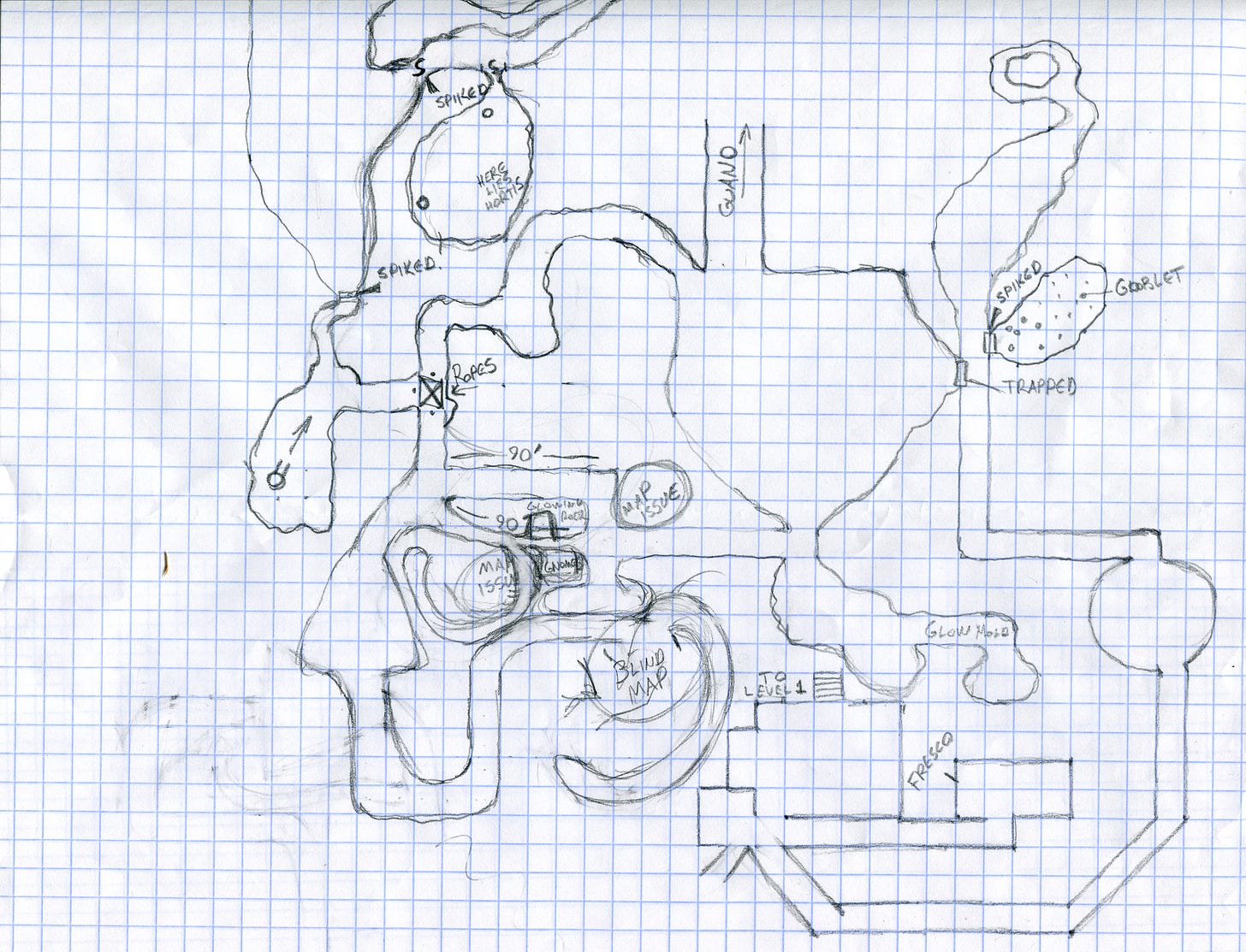Herein find the origin story of the most unlikely hero of our run through Moldvay D&D, X the Veteran. The events recounted in this session inspired my analysis of Dungeons & Dragons: Basic Set as well as informing the design of our RPG Torchbearer. If you haven’t already, you can read my analysis starting with this post.
Our story begins with our characters standing around a magic rock, chipping off bits and eating them. Don't ask why—it's In Search of the Unknown.
We had six players embodying six characters in the following configuration: a fighter, a dwarf, a magic user, a cleric, a thief and a bandit.1 It was a robust first-level party.
The rules of Moldvay D&D insist we assign a mapper, a back-up mapper and a caller. We dutifully obliged. The roles of the mappers and caller rotate each session. The rules suggest it and it's a good way to get everyone involved and make sure no one is left out. When we began the campaign, there were groans about mapping. Some of the players new to D&D wondered aloud why we had to do such a thing. One veteran of another kind of D&D made lots of disgruntled noises about mapping. After the events of this sessions unfolded, no one ever complained again.
X Eats a Magic Rock and Instantly Regrets It
The adventurers took turns chipping off pieces of rock and eating them. One chip turned turned the cleric invisible and another chip teleported the fighter, X, to another unexplored room of the dungeon. X was the primary mapper.2
Our lost fighter was alone…in the dark. Since he was mapping, he couldn’t carry a torch or lantern. The caller had been carrying the light for him. Even though he had one of the group’s maps, he couldn’t make use of it until he manifested some light.
Using his sword as a walking stick, X managed to discern that he was in a sort of cul-de-sac with a webbed entranced. Huddling into the corner, he shredded some hemp rope that he had in his pack and rubbed the heads of two crossbow bolts together to spark a fire. We resolved the situation with a Wisdom check. He has a Wisdom 11 and managed to pass the test. With light, he could see that he was alone in an unfamiliar section of the dungeon. And there was the matter of the webs. He was on edge.
After burning his way out of the webs, he carefully navigated through the area. In order to create a sense of dislocation, I stopped providing compass directions (as is customary in our dungeon exploration). Instead, I described everything as right, left, forward and back. And I only described what he could see—by rule, only 30' around him by torchlight. After an hour of in-game exploration (necessitating two wandering monster checks and one torch expended), he managed to find his way back to familiar territory on his map. Once he was reoriented, he sauntered toward a passage that lead to an exit. But there he spotted multiple sets of beady, black reflective eyes attracted by his torchlight (my next wandering monsters check came up positive). These creatures seemed to be mucking about with a pit trap that the party had disarmed earlier. He beat a hasty retreat down a long side passage and hid. There, much to my surprise, he described his character dousing his torch and moving back in the direction of the pit creatures.
As we all know, D&D underdwellers can see in the dark (but usually only out to 60'). This plan was only going to get him killed. Or so I thought. There were three possible passages he could have retreated down. All were longer than these creatures could see. So I rolled randomly to determine which one they were checking and didn't tell him. He told me he wanted to touch the right hand wall with his hand and move quietly along it, following its curve. At this point, all of the other players were watching and listening, cringing at his description of each careful step.
I told the player to make a Dex check. According to my calculations, X had stepped out behind the creatures and was moving away from them. They weren't looking in his direction, but they were RIGHT THERE. He has a Dex of 8. You should have heard his voice crack when he announced that he had passed the test. He moved away from his pursuers with a firm plan in mind to follow this wall until he could reorient himself.
As he moved in this direction, I described a faint odor of smoke. When he stopped at a junction, I told him he could hear the popping of bones and the tearing of sinew in the distance. And he could hear a quiet voice whispering in a language he couldn't understand. He continued onward. An arrow whistled through the air and cracked against the wall next to him. He flinched, but he kept going. Unfortunately, his map of this area wasn't completely accurate. Describing how his character moved, telling me which hand he was using to follow the wall, he ended up in a room with no exit. 3 His stalkers followed him into the room and blocked the exit.
With nothing to lose he says, "I parlay. 'I suppose you want my treasure.'" We rolled on the reaction chart (adding his +1 Charisma bonus) and came up with the Monster Uncertain result. So I rolled a 1d6 for each hobgoblin to determine if they spoke his language (since they were accomplished marauders, it seemed plausible). A result of 1 would indicate they did. The dice said that one of their number did. The multi-lingual robber promptly instructed X to dump his treasure. X readily complied. Due to the uncertain result, we rolled again on the reaction chart to determine how they reacted to his gesture. This time he got an "Enthusiastic" response. So they laughed, clapped him on the back and told him he could be on his way, but before he left, the fluent hobgoblin asked, "Hey, could we borrow a couple of torches?"
"Sure, what for?"
"Don't ask."
Shaking but relieved to be alive, he took a moment to try to light another torch and failed. Still shaking and still in the dark, he pressed on. Shortly, he came within in sight of a glowing cave that the group had already plundered. His light-deprived eyes drank deep and he took a moment to ignite his own torch. He knew where he was. Moving confidently but cautiously now, he made a circuitous journey to his goal: the stairs up to the first level. However, path to the dungeon exit that his friends had escaped from was now blocked by at least two groups of creatures.
The turn tracker indicated that it was time for another wandering monsters check. The die roll came up positive. Bad luck for him. Making the requisite rolls, I determined that a huge spider dropped from the ceiling 40' behind him. Perhaps it was the creature whose web he burned, coming to investigate. Regardless, both character and monster were surprised (I suppose the player was too). Without hesitation he blurted, "I run!" They had fought two of these creatures already. X knew how tough and deadly they could be. The spider pursued. Consulting the rule book, I referenced their respective movement rates, and it appeared that they were the same. The player asked to have his character toss his armor off so he could run faster, but I noted that he had a torch in one hand and the map in the other. No free hands to do anything unless he wanted to either drop one item or stop.
X Marked the Spot
At this moment, the nature of his predicament clicked in for X’s player: The spider couldn't catch him so long as he successfully navigated to the exit.
The player nervously rattled off directions according to his map. As he recited his choices, I checked them against my map to note any wrong turns or inaccuracies. When he found the stairs to the upper level, in my evil dungeon master nature, I let the spider close half the distance since it could take some vertical shortcuts.
Once at the top of the stairs, the player rapidly produced his map of the upper level of the dungeon which X kept safely tucked in his pack. He described a move and then cursed. "No. Fuck." He'd taken a wrong turn.
"Oh yes," I intoned darkly. I had seen his mistake on my master map. Instead of heading for the exit, he was heading down a passage that had two options: an outlet and a dead end. The player quickly reoriented X toward the outlet. The spider followed patiently. Waiting for him to make a fatal mistake.
He headed through a door the group had previously unlocked, slammed into the far wall, turned left and ran for his life. Ahead of him was a secret door that the group had spiked open when they initially explored the upper level. He dashed through it and from there down a flight of stairs and out to the exit. The spider didn't pursue beyond the dungeon. He wasn’t that kind of spider.
The player’s voice quavered. "Shaking. My hands are shaking."
Everyone cheered.
"I can't believe you're alive!"
"Me neither! You bastards! You left me!"
"It was that map. The map saved you," noted one of the initial map doubters.
Everyone agreed. Everyone looked at the map in the player’s hands with renewed interest and understanding. Without the map it would have been a total-party-kill. With the maps, they survived. It was a revelatory experience. What seemed like antiquated drudgery transformed into exciting and meaningful work.
Next week, we continue to reflect on the game. We’ll discuss the game’s vital player meta-roles, the caller and the mapper. Until then, we remain your Ludological Alchemists.
Want more? You can also listen to our companion podcast here.
One player recently took control of a bandit NPC working with the group after his original character perished. There were so many bandits who joined up with our group, I eventually made a class for them which I intend to publish on Ludological Alchemy as subscriber content.
Fortunately, the main group still had its back-up mapper (the former bandit). Spooked, the five characters remaining in the main group still at the rock decided to desist their lithovorish ways and headed for the surface. Of course before they left, they wanted to check out this one little tunnel on the map. They got confused and a little turned around…and were ambushed by five hobgoblins who had been hiding out in a small room at the end of the questionable passage. The group had passed this way before but the hobgoblins had remained hidden—since they were out-numbered. Now it appeared the group had been diminished: it seemed there were only four remaining. So they ambushed them and demanded all of their treasure. The group parlayed but couldn't sway the hobgoblins. Neither would they give up their treasure! Thus, a bloody melee ensued. The invisible character—a rather formidable cleric—just missed her surprise attack and was subsequently killed by an enraged hobgoblin. The valiant dwarven veteran commanded his friends to retreat while he held off the attackers. He was slain after sustaining two brutal blows. The clever mage tossed oil to cover their retreat and the two surviving thieves and the mage used their map to beat a hasty retreat to one of the dungeon exits. To use the map, they had to describe to me the turns they were taking and the rooms they were entering. I didn't describe the dungeon to them. I only confirmed their location by repeating familiar descriptions.
And his pursuers were the self-same hobgoblins who had run off his companions.









I WAS THERE. It was epic.
Mapping is incredibly hard — esp. translating the DM's descriptions into (semi)accurate corridors, passages, chambers and rooms. So many janks and dog-legs. The fact that the map is a physical object made it into Torchbearer and it presents all kinds of challenges when a conflict arises — what to keep? What to drop? A whole 'nother level of decision-making.
Exciting read! Makes me want to go back and try d&d again. But then again we have TorchBearer now.